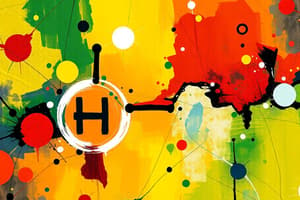Podcast
Questions and Answers
Explain how an ionic bond is formed, and identify the types of atoms involved.
Explain how an ionic bond is formed, and identify the types of atoms involved.
Ionic bonds are formed when a metal atom transfers electrons to a nonmetal atom, creating oppositely charged ions that attract each other.
What are the characteristics of ionic compounds in terms of their state, melting/boiling points, and electrical conductivity?
What are the characteristics of ionic compounds in terms of their state, melting/boiling points, and electrical conductivity?
Ionic compounds are typically crystalline solids, have high melting and boiling points, and conduct electricity when molten or in aqueous solution.
Describe how covalent bonds form and which types of atoms are involved in their formation.
Describe how covalent bonds form and which types of atoms are involved in their formation.
Covalent bonds form through the sharing of electrons between nonmetal atoms to reach a stable electron configuration.
In general, how do the melting and boiling points of covalent compounds compare to those of ionic compounds?
In general, how do the melting and boiling points of covalent compounds compare to those of ionic compounds?
Explain why covalent compounds typically do not conduct electricity.
Explain why covalent compounds typically do not conduct electricity.
What is the concept of hybridization in the context of covalent bonds?
What is the concept of hybridization in the context of covalent bonds?
Differentiate between sp, sp², and sp³ hybridization, in terms of molecular geometry.
Differentiate between sp, sp², and sp³ hybridization, in terms of molecular geometry.
How does hybridization influence the bond angles in covalent compounds?
How does hybridization influence the bond angles in covalent compounds?
Flashcards
Chemical Bonding
Chemical Bonding
The joining of two or more atoms to form molecules or compounds.
Stable Electron Configuration
Stable Electron Configuration
Atoms achieve stability by having a full outer electron shell, resembling noble gases.
Ionic Bonding
Ionic Bonding
Occurs when a metal atom loses electrons to form cations and a nonmetal gains them to form anions.
Electrostatic Attraction
Electrostatic Attraction
Signup and view all the flashcards
Covalent Bonding
Covalent Bonding
Signup and view all the flashcards
Hybridization
Hybridization
Signup and view all the flashcards
Types of Covalent Bonds
Types of Covalent Bonds
Signup and view all the flashcards
Molecular Geometry
Molecular Geometry
Signup and view all the flashcards
Study Notes
Chemical Bonding
- Chemical bonding is the joining of two or more atoms to form molecules or compounds.
- It's driven by the atoms' desire to achieve a stable electron configuration, often resembling the noble gases.
- Types of chemical bonds include ionic, covalent, and metallic.
Ionic Bonding
- Ionic bonding occurs when a metal atom loses one or more electrons to form a positive ion (cation), and a nonmetal atom gains those electrons to form a negative ion (anion).
- The electrostatic attraction between oppositely charged ions forms the ionic bond.
- Ionic compounds are typically crystalline solids at room temperature.
- They have high melting and boiling points due to the strong electrostatic forces between ions.
- Examples of ionic compounds include sodium chloride (NaCl) and magnesium oxide (MgO).
- Ionic compounds conduct electricity when molten or in aqueous solution because the ions are free to move.
Covalent Bonding
- Covalent bonding involves the sharing of electrons between atoms.
- This sharing typically occurs between nonmetal atoms.
- Atoms share electrons to attain a stable octet configuration, similar to noble gases.
- Covalent bonds can be single, double, or triple bonds, depending on the number of electron pairs shared.
- Covalent compounds can exist as gases, liquids, or solids at room temperature.
- Their melting and boiling points are generally lower than those of ionic compounds.
- Examples include water (H₂O) and methane (CH₄).
- Covalent compounds often do not conduct electricity in any state.
Hybridization
- Hybridization is a concept used to explain the shapes of molecules formed by covalent bonds.
- It involves the mixing of atomic orbitals of different energies to form new hybrid orbitals.
- The new hybrid orbitals have different shapes and energies from the original atomic orbitals.
- The resulting shapes predict the bonding patterns of covalent compounds.
- Examples include sp, sp², and sp³ hybridization, which result in linear, trigonal planar, and tetrahedral molecular geometries, respectively.
- The different types of hybridization result in different bond angles and molecular shapes.
Studying That Suits You
Use AI to generate personalized quizzes and flashcards to suit your learning preferences.




